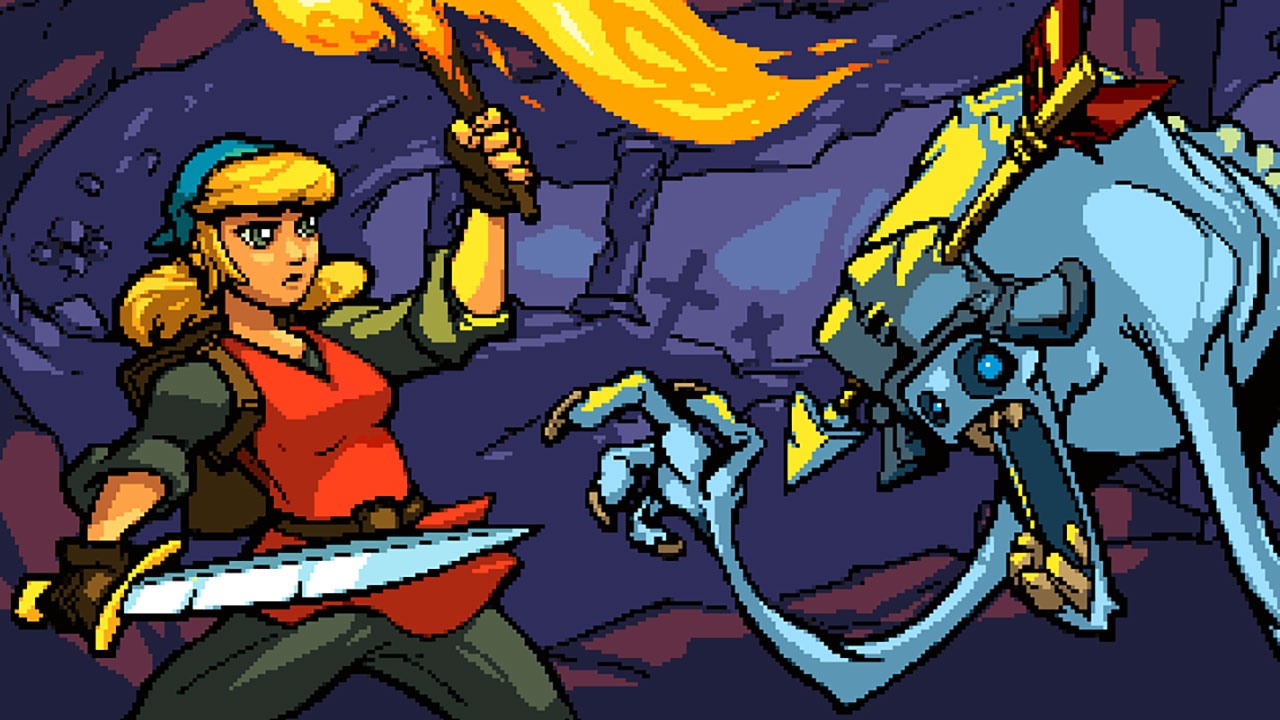Have you ever heard of a medical condition called Tetris Syndrome? If you haven’t, you may well be familiar with its symptoms: Tetris Syndrome is the name given to the phenomenon where you start to see the world as a series of shapes to be slotted together, caused by prolonged sessions on the classic puzzle game.
Other, unnamed but similar states of mind exist. Long sessions on Assassin’s Creed might see you viewing the world as a giant parkour playground. Spend too much time in Agent 47’s world, and you could find yourself viewing the world around you as a giant murder box.
Best not admit to that last one, though.
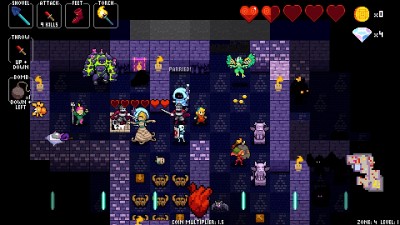 Crypt of the Necrodancer is another game that will worm its way into your head and stay there. Except you wont be fitting shapes together, or finding the ideal hypothetical way to bump off your neighbor – you’ll end up doing everything to an unheard rhythm, like some kind of human metronome. You’ll descend the stairs to the beat; you’ll brush your teeth to the beat. Suddenly, everything in the world will seem to be operating on its own rhythm.
Crypt of the Necrodancer is another game that will worm its way into your head and stay there. Except you wont be fitting shapes together, or finding the ideal hypothetical way to bump off your neighbor – you’ll end up doing everything to an unheard rhythm, like some kind of human metronome. You’ll descend the stairs to the beat; you’ll brush your teeth to the beat. Suddenly, everything in the world will seem to be operating on its own rhythm.
Before you know it you’ll find yourself reaching for your mp3 player to cycle to the next track, only to realize that the music you’re hearing is just your brain playing tricks on you – the end result of Super Meat Boy composer Danny Baranowky’s excellent soundtrack worming its way into your brain.
Crypt of the Necrodancer sounds on paper as though it really shouldn’t work. Taking the entirely different genres of roguelike RPG and 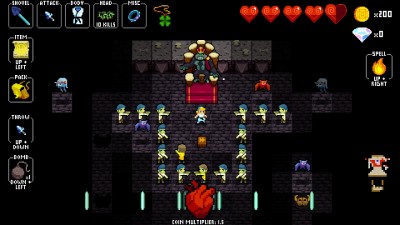 rthym-action and mashing them together with a 16-bit pixel aesthetic, Brace Yourself Games’ debut sees you attempting to survive a journey through a series of randomly-generated dungeons. The twist is that everything you do needs to be in time with a driving chiptune soundtrack.
rthym-action and mashing them together with a 16-bit pixel aesthetic, Brace Yourself Games’ debut sees you attempting to survive a journey through a series of randomly-generated dungeons. The twist is that everything you do needs to be in time with a driving chiptune soundtrack.
Everything in Crypt of the Necrodancer operates on rhythm. Enemies move on time with the beat; kill enemies in time with the beat, and your multiplier increases and the floor tiles light up like an old-school disco dancefloor. Miss a beat, or skip it altogether, and your multiplier disappears.
Kill the boss monster on each floor and descend to the next, and you’re greeted with a new music track with a new tempo, a new dungeon and often new monsters – each with their own patterns of movement to learn. A giant golem might only move on every fourth beat, allowing you to get three hits in before moving back a space to avoid its advance. A floating jellyfish will alternate between intangible and vulnerable. A red dragon will breathe fire in a straight line across the entire screen, making it one of the more fearsome opponents you’ll face. Each enemy has its own patterns to learn and perfect, and the game throws them at you in continually challenging combinations with every playthrough - so much so that the game never feels quite as random as it actually is.
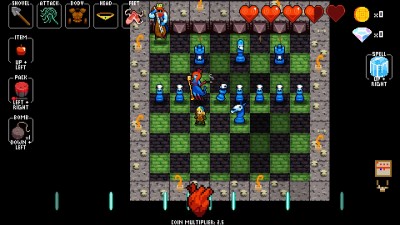 Four different zones are included in the game, each with their own tilesets and unique themes, enemies and quirks and bookended by a boss encounter randomly selected from a pool. The second zone features mushrooms, some of which might explode, and certain enemies disguise themselves as a section of wall, relentlessly pursuing you once you get too close. Zone 3 adds fire and ice to the mix. Ice is slippery as you might expect, but can be melted by fire into a puddle of water - which takes an extra two steps to move through. What seem like minor changes actually drastically change how you approach each level.
Four different zones are included in the game, each with their own tilesets and unique themes, enemies and quirks and bookended by a boss encounter randomly selected from a pool. The second zone features mushrooms, some of which might explode, and certain enemies disguise themselves as a section of wall, relentlessly pursuing you once you get too close. Zone 3 adds fire and ice to the mix. Ice is slippery as you might expect, but can be melted by fire into a puddle of water - which takes an extra two steps to move through. What seem like minor changes actually drastically change how you approach each level.
More playable characters are unlcoked as you progress, each with their own quirks that mix up the gameplay and their own personal storyline. The Bard sees the game switching to turn-based gameplay; you no longer need to move in time with the music, but enemies take their turn with every move. It can be tempting to speed through levels as quickly as possible, though if you’re not careful you might find yourself surrounded by enemies sooner than you expect. Play as Eli, and instead of attacking enemies with your main weapon you’ll need to drop and kick bombs towards your enemies - more challenging than you might expect, as you need to make sure you’re not inside the blast radius when they go off.
There’s plenty more to unlock, too. Diamonds are the game’s primary currency, spent in the hub area after each run. Diamonds can be spent on unlocking new random items, which appear during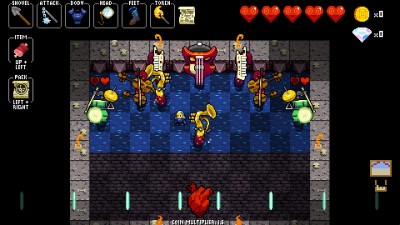 each dungeon run, but there also spells to unlock. They can also be spent on unlocking a small selection of persistent upgrades, though these are limited in number.
each dungeon run, but there also spells to unlock. They can also be spent on unlocking a small selection of persistent upgrades, though these are limited in number.
It won’t be long before you’ve unlocked everything, however; given how often you come across the currency in each run, a little more longevity could have been added to the metagame by providing a deeper pool of items to unlock and upgrade.
Still, the infectious music and desire to perfect your run means that there’s plenty to keep you occupied, and the game even supports custom soundtracks if you grow bored of the music included in the game (which is unlikely). There’s something oddly satisfying about playing a dungeon to Guns ‘n’ Roses’ Welcome to the Jungle.
Little touches abound, showing just how much love and thought has been put into the game. Stumble upon a shopkeeper in a dungeon and they start to sing along with the music; Zones can be tackled individually or one after the other in a single run, and both single-player and co-op are supported. You can even play with a dancemat, if you’re after an authentic Bemania experience.
Crypt of the Necrodancer features Steam Workshop support too, with plenty of user-made mods already available to download. At the time of writing there’s around 1,600 mods available, ranging from new playable characters and remixed versions of the soundtrack to custom-designed levels and new items. Fancy playing as Captain Falcon or Pikachu while battling through a recreation of your favorite Fire Emblem dungeon, and replacing a load of items and sound effects with references to Deus Ex? Well, you can do that.
Crypt of Necrodancer is a game that looks and sounds like a novelty, but turns out to be anything but. Its unforgettable soundtrack will bore its way into your skull until you find yourself humming its tunes while making your morning coffee; its gameplay has that classic one-more-go appeal; and its simple mechanics hide a deep level of challenge. It’s not often that I say this, but based on the strength of its debut, Brace Yourself Games may well be one of the most exciting indie studios in gaming today.
Buy it, play it, love it - and then become a slave to rhythm. Crypt of the Necrodancer is one of the best indie games to be released in a very long time.
